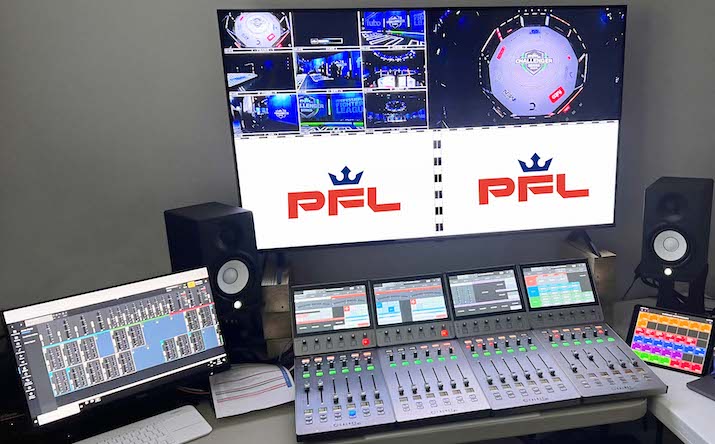Two A1s Aim To Leverage the Gaps in the REMI Model
A shortage of experienced audio engineers is one issue behind the effort
Story Highlights
Broadcast sports’ lead audio mixers — the A1s — tend to lead solitary existences. They’re usually the only person in their compartment in a production truck or a loft in a venue and are expected to solve any problems on their own. That isolation was compounded by COVID, when various remote-operations protocols, often referred to as REMI, were accelerated and crews were compelled to work from home or other remote locations.
However, when two A1s get together, all that separateness quickly gives way to collaboration, and that’s what happened when two audio veterans — Sean O’Gorman and Shawn Peacock — shared ideas about how to leverage the remote-operations trends of the last several years.
“One of the results of the pandemic has been that many entities have built out regional ‘pod’-based production facilities to handle REMI,” explains O’Gorman, who has mixed college football, NHL, the Olympics, and other sports. “But one issue with these facilities has been finding high-quality, experienced audio engineers at a competitive pay scale to handle the massive number of events they have to cover — think RSNs. Often, the inexperience of ‘local’ engineers has led to networks’ having to fly in experienced engineers to these remote facilities.”

For Universal Remote’s Sean O’Gorman, the goal is “to maximize the time experienced engineers are sitting behind a console and minimize the time they’re sitting on a plane.”
As a result, he says, “the REMI model isn’t working properly. The way we look at it is, there really is no difference if you’re flying someone to a game site or to Stanford, CT, to mix the NBC REMI. You’re still moving people around, and that’s expensive. There’s no net gain to flying an engineer to a studio and putting them up at a hotel as opposed to flying them to a mobile unit.”
To counter that, he and Peacock this year formed Universal Remote.tv, looking to create a service template that could pair a cost-effective technology platform with qualified A1s anywhere in the U.S. or elsewhere. The A1s could mix the audio for sports broadcasts remotely, at a significantly reduced cost to the broadcaster and/or league, with most of the savings coming from the absence of travel-related costs.
The goal, says O’Gorman, is “to maximize the time experienced engineers are sitting behind a console and minimize the time they’re sitting on a plane.”
Proof of Concept
The concept was proven out on the world feed of the Professional Fighters League (PFL) preseason build-up event at Universal Studios in Orlando, which ran from late January to late February. O’Gorman mixed the main feed onsite at Universal Studios on an Artemis console in the production truck, and Peacock mixed the Spanish and world feeds from his home in central Florida.

Universal Remote’s Shawn Peacock: “It’s economically viable to ship the control surfaces to wherever the A1 is.”
The platform for Peacock’s mix was Calrec’s Type R modular broadcast mixer, which comprises a processing core, control surface, and I/O system and is controlled remotely over IP through AES67/ST 2110-30 interfaces.
“It’s economically viable to ship the control surfaces to wherever the A1 is, with the core in the OB truck, [and set it] up in a control room in their house,” says Peacock, whose career has encompassed mixing college football, X Games, tennis, and motorsports including NASCAR and SRX Racing. “The Type R is compact and modular, allowing us to keep all the DSP at the OB truck onsite and feed the control signals from the A1’s [location] to the truck.”
Technically, the remote-mixing process is straightforward. Besides the Type R platform, O’Gorman and Peacock set up their own audio monitoring, the only actual audio signals in the transport path: the audio signals aren’t shipped into the console remotely; the broadcast audio does not leave the event site other than backhaul to broadcast transmission.
All that is done over the pair’s own VPN, hosted through AWS. For the PFL series, which was broadcast on ESPN, the Type R was integrated on Universal Remote’s network over a Dante network with latency fixed at 175 ms, between an A1’s selecting a source and hearing it.
Addressing the Human Factor
What’s less clear-cut is the human side of the equation. As the amount of sports on television continues to proliferate, the number of highly qualified A1s to mix it isn’t, a condition that remains a major problem confronting the entire broadcast-sports industry. Peacock and O’Gorman will rely on themselves and their own digital Rolodexes of top-tier technical talent to recommend as mixers.
They’ll also have to work to encourage broadcasters to be more receptive of their operational model: although the COVID emergency did spawn a number of home-based mixing scenarios, Peacock points out, those were generally temporary and one-off situations. “I’m not aware of anything where this was a regular weekly option, where [engineers] were mixing from their homes or from remote locations that were separated from the rest of the production facility.”

Universal Remote proved out its concept on a Professional Fighters League preseason event at Universal Studios in Orlando.
In fact, adds O’Gorman, REMI was a mutable concept from the beginning, depending on the network deploying or defining it. “REMI can be a lot of different things to a lot of people. It checks a lot of different boxes.”
As a result, Universal Remote’s business model is still evolving. Hardware and related issues are clear — O’Gorman says they intend to acquire the consoles that the company will deploy, to ensure plug-and-play reliability for live productions — but the personnel side, understandably, is dependent on a limited pool of technical talent. He makes clear that Universal Remote is not in the staffing business but says the advantage it brings is that any referrals will be to highly qualified engineers — including themselves. Their availability won’t be constrained by airport delays, he adds, and costs will be lower because they won’t have to be traveled to production sites. Universal Remote’s vig will derive from the reduced-cost margins.
In fact, O’Gorman asserts, Universal Remote’s approach can help mitigate personnel shortages by better utilizing the time of those who are available. “There’s definitely a shortage of a A1s, but, if you look at available working hours per week and shows that need to be filled versus time not spent traveling, there’s actually more availability than you might have thought.”
Peacock and O’Gorman credit Calrec for providing the platforms for their idea’s proof of concept, and PFL’s Larry Rogers for letting them use the eight-week series to test it out. The venture has no concrete future productions on its schedule, but O’Gorman says it’s especially suited initially to non–major-league productions comprising multiple events in a series, which help offset the cost of hardware and shipping.
“We’ve set that as a kind of foundation,” he says. “From that, we can expand.”
